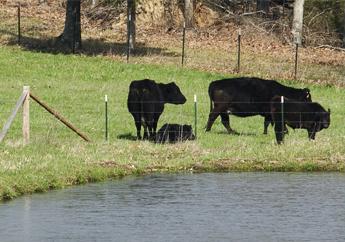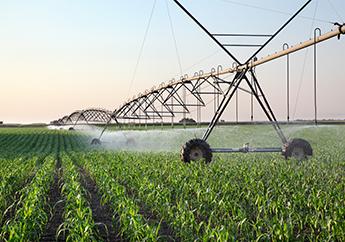Missouri Geological Survey Director: Carey Bridges, RG
The Soil and Water Conservation Program currently offers more than fifty individual cost-share practices to farmers. All of these practices are designed to either reduce erosion or protect water quality, but many also have the potential to reduce the impacts of drought on the land, livestock and bottom line of farmers across the state. The following is a summary of current cost-share practices and potential drought related benefits organized by resource concern.

Sheet, Rill and Gully Erosion
Seeding Practices
A native warm season grass component is available to use for seeding practices in this resource concern. Native warm season grasses are known to be more tolerant of drought and more productive in the hot summer season when drought impacts are most likely in our state. When farmers incorporate these grasses into their farming systems, they have the potential to provide additional hay and forage for livestock, as well as live, productive ground cover during hot and dry periods when compared to cool season options such as fescue.
DWC-01 - Water Impoundment Reservoir
Water impoundment reservoirs are constructed to address gully erosion concerns, but current program policy allows the installation of pipe, valves, hydrants and tanks with cost share assistance when building a pond. This water can then be used to supplement livestock and crop needs without additional pumping equipment during times of drought.
N340 - Cover Crop
Cover crops are offered as a practice because of their ability to reduce erosion in between cash crops, but they also have the potential to be an important tool to increase drought resiliency on farms, particularly when coupled with no-till and used long term. Long term cover crop use has been proven to increase soil organic matter, infiltration rates and water holding capacity, all of which make a field more resistant to drought impacts. In addition, in some cropping systems such as when soybeans are no-tilled into cereal rye, the mulch provided by cover crops helps to reduce evapotranspiration and reduce competition from weeds. Cover crops can also provide an important alternative or emergency source of feed for livestock in the form of grazing.
Grazing Management

DSP 3.1 - Grazing System Water Development
The water development practice provides cost-share for drilling a well, building a pond or hooking up to a rural municipal water system. Water development projects such as these reduce reliance on surface waters such as old ponds and streams and facilitate the more efficient distribution of available water to individual grazing paddocks.
DSP 3.2 - Grazing System Water Distribution
This practice provides cost-share for the pipeline and tanks needed to serve a managed grazing system. Properly placed watering points help distribute manure evenly, and increase pasture utilization rates. Reliable water in every paddock ensures that all the forage available can actually be used in times of drought. Rotating livestock through a managed grazing system increases forage production and health. Long term use of a rotational grazing system can improve soil organic matter, water infiltration rates, and water holding capacity.
DSP 3.3 - Grazing System Fence
The benefits of developing water systems can never be fully utilized without the cross-fencing to divide a system into the appropriate size and number of paddocks to allow for efficient forage utilization and adequate forage rest periods.
Irrigation Management
N430 - Irrigation Water Conveyance
This practice helps to install the pipeline and valves necessary to efficiently get irrigation water from the source to the application point. This usually means installing an underground pipeline that replaces an open ditch or other obsolete method of moving water around the farm. This results in less total water being needed to apply a given amount to a crop.

N442 - Irrigation System, Sprinkler
Cost-share is provided to re-nozzle existing sprinkler irrigation systems with more modern and efficient equipment. This reduces the total amount of water needed to apply a given amount to a crop.
N443 - Irrigation System, Surface and Subsurface
This practice helps to increase the efficiency of existing furrow irrigation systems which in turn reduces total water needs for the farm.
N447 - Irrigation System, Tail Water Recovery
This practice helps to design and install a system that collects and stores excess irrigation water and runoff from rainfall that can later be applied or re-applied to crop fields. This reduces the overall dependence on groundwater for irrigation.
N587 - Structure for Water Control
Water control structures are used to artificially adjust the water table in a given field. These can be used to help retain more water in the soil profile for a crop during times of drought.
Animal Waste Management
N312 - Beef and Small Ruminant Waste Management
The intent of this practice is to provide a place to properly store the animal waste and reduce the environmental impacts generated by feeding livestock. Sometimes these are designed as winter feeding facilities for feeding hay. Those facilities could also be used to feed livestock in times of drought, which would reduce impacts on already stressed forages.

Sensitive Areas
N386 - Field Border
Field borders provide erosion and water quality benefits by intercepting field runoff. These field borders also replace the outside crop rows that usually yield less than inner rows. This yield drag is usually more pronounced in drought years. These borders also can provide additional livestock forage or hay which could be utilized in dry years.
N574 - Spring Development
This practice helps farmers develop existing springs so that the water can be captured and used for livestock watering without degrading the resource. Where springs are present this can be an important and reliable source of water that facilitates grazing areas that might not otherwise be possible in times of drought.
Nothing in this document may be used to implement any enforcement action or levy any penalty unless promulgated by rule under chapter 536 or authorized by statute.
For more information
Soil and Water Conservation Program
Missouri Geological Survey
P.O. Box 176
Jefferson City, MO 65102-0176
United States
